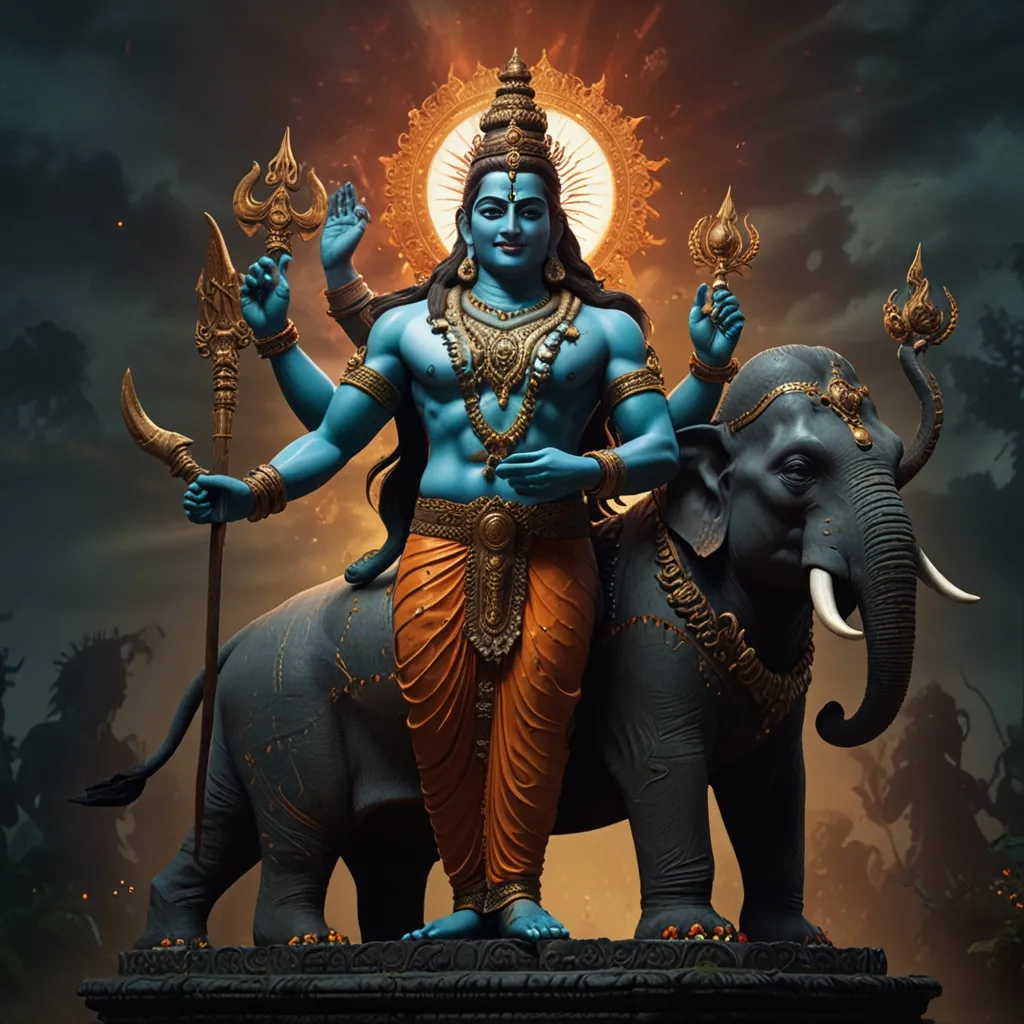Hindu mythology is a treasure chest of fascinating tales with gods, demons, bravery, and lessons that run deep. One such intriguing story is the legend of Shiva and the demon Gajasura, a tale that’s been passed down through generations, each time with its unique embellishments and teachings. This story shines a spotlight on Shiva’s divine power and explores themes like piety, penance, and the age-old victory of good over evil.
Gajasura, which translates to “elephant demon,” was quite different from your typical demon. Unlike the usual rowdy, havoc-wreaking entities, Gajasura was a devout, spiritually inclined being with a deep-seated reverence for Lord Shiva. His devotion was so intense that it compelled him to embark on rigorous penance. Seeing Gajasura’s sincerity and dedication, Shiva couldn’t help but grant him a boon. Gajasura, with humility and devotion, requested that Shiva reside within his stomach. Known for his compassion and inability to refuse a genuine devotee, Shiva agreed and shrunk himself to enter Gajasura’s body.
Meanwhile, things weren’t looking too good for Devi Parvati, Shiva’s consort. She was worried sick as Shiva had been MIA for quite a while. To get to the bottom of this, she turned to Lord Vishnu for help. Vishnu, ever the clever strategist, disguised himself as a musician and, with Nandi, performed an enchanting concert in front of Gajasura. The demon was so spellbound by the music that he promised Vishnu anything he desired. Vishnu, knowing exactly what to ask for, requested Shiva’s release from Gajasura’s stomach. Realizing who the musician really was, Gajasura instantly complied.
There’s another spin to this tale where Gajasura is portrayed as the son of Mahishasura, another notorious demon who met his end at the hands of Devi Durga. Gajasura, looking to avenge his father’s death, underwent severe penance and was granted immense power by Lord Brahma. This newfound strength went straight to his head, corrupting him, and he began terrorizing the three worlds. The gods, in utter dismay, begged Shiva for help. Shiva, with his fierce demeanor, confronted Gajasura in a ferocious battle and ultimately took him down with his trident. As a last act of humility before his death, Gajasura requested that Shiva adorn his elephant hide as a symbol of his devotion. Shiva, moved by this gesture, granted his wish.
Yet another version of the story comes from the legends around the sages of Darukavanam. These sages, growing arrogant, decided to challenge Shiva’s supreme power. Shiva and Vishnu decided to teach them a lesson, with Shiva appearing as Bhikshatanamurthy, a beguiling mendicant, and Vishnu as Mohini, an enchantress. The sages’ wives were drawn to Bhikshatanamurthy, and the sages themselves couldn’t resist Mohini. Once they realized they’d been tricked, the sages created Gajasura through sacrificial fire to destroy Shiva. But, Shiva, being Shiva, entered Gajasura’s body, only to tear it apart from within, performing his epic tandava dance in the end.
There’s also a tale of Gajasura terrorizing the city of Kashi, spreading chaos and fear. The gods, once again at a loss, turned to Shiva for salvation. Shiva took on Gajasura, and despite the demon’s formidable powers, skewered him with his trident. As he lay dying, Gajasura acknowledged Shiva’s overwhelming glory and requested to have his elephant hide worn by Shiva. Feeling a mixture of respect and sympathy, Shiva agreed, adding the hide to his array of divine attire.
The story of Gajasura isn’t just an action-packed saga; it’s loaded with symbolism. Many interpret it as a metaphor for taming one’s senses and achieving spiritual enlightenment. The black elephant, often seen as symbolizing the deceitful world, is transformed into the white elephant of knowledge, underscoring the victory of good over evil.
The visual representations of Gajasurasamhara, the form of Shiva as Gajasura’s slayer, are striking and powerful. Shiva is frequently depicted with multiple arms, each bearing weapons and the skin of the elephant. His left foot presses down on the elephant’s head while his right leg is bent and raised, with the tail of the elephant appearing behind Shiva’s crown. Typically, Devi Parvati stands nearby, holding their son Skanda, both visibly uneasy due to Shiva’s fierce form.
Art from various Indian temples vividly captures these scenes, with each region putting its own artistic spin on the event. A notable example can be seen at the Hoysaleshwara temple in Halebid, which features a spectacular sculpture of Gajasamharamurthy. Here, Shiva is shown with eight arms, emerging from the elephant’s body, his right leg firmly planted on the elephant’s head and his left leg elegantly folded. The hide of the elephant is creatively wrapped around Shiva, almost like a divine halo, with Parvati depicted next to him, visibly scared.
This epic tale of Shiva and Gajasura is more than just an ancient story; it’s a testament to the timeless themes embedded in Hindu mythology. Whether Gajasura is portrayed as a benevolent devotee or a powerful, terrorizing force, his story ultimately highlights the divine power of Shiva and the transformative power of true devotion. From protecting his devotees to teaching the arrogant a lesson, Shiva’s narratives serve as enduring reminders of the triumph of good, humility, and devotion in the grand, often tumultuous, tapestry of life.






